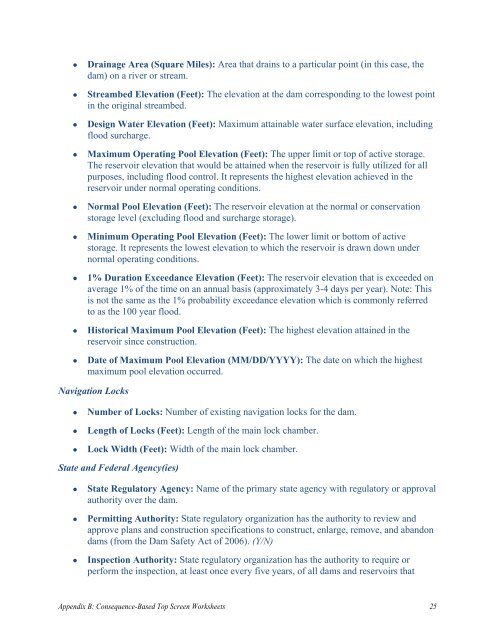Dams Sector Consequence-Based Top Screen Methodology
Dams Sector Consequence-Based Top Screen Methodology
Dams Sector Consequence-Based Top Screen Methodology
Create successful ePaper yourself
Turn your PDF publications into a flip-book with our unique Google optimized e-Paper software.
• Drainage Area (Square Miles): Area that drains to a particular point (in this case, the<br />
dam) on a river or stream.<br />
• Streambed Elevation (Feet): The elevation at the dam corresponding to the lowest point<br />
in the original streambed.<br />
• Design Water Elevation (Feet): Maximum attainable water surface elevation, including<br />
flood surcharge.<br />
• Maximum Operating Pool Elevation (Feet): The upper limit or top of active storage.<br />
The reservoir elevation that would be attained when the reservoir is fully utilized for all<br />
purposes, including flood control. It represents the highest elevation achieved in the<br />
reservoir under normal operating conditions.<br />
• Normal Pool Elevation (Feet): The reservoir elevation at the normal or conservation<br />
storage level (excluding flood and surcharge storage).<br />
• Minimum Operating Pool Elevation (Feet): The lower limit or bottom of active<br />
storage. It represents the lowest elevation to which the reservoir is drawn down under<br />
normal operating conditions.<br />
• 1% Duration Exceedance Elevation (Feet): The reservoir elevation that is exceeded on<br />
average 1% of the time on an annual basis (approximately 3-4 days per year). Note: This<br />
is not the same as the 1% probability exceedance elevation which is commonly referred<br />
to as the 100 year flood.<br />
• Historical Maximum Pool Elevation (Feet): The highest elevation attained in the<br />
reservoir since construction.<br />
• Date of Maximum Pool Elevation (MM/DD/YYYY): The date on which the highest<br />
maximum pool elevation occurred.<br />
Navigation Locks<br />
• Number of Locks: Number of existing navigation locks for the dam.<br />
• Length of Locks (Feet): Length of the main lock chamber.<br />
• Lock Width (Feet): Width of the main lock chamber.<br />
State and Federal Agency(ies)<br />
• State Regulatory Agency: Name of the primary state agency with regulatory or approval<br />
authority over the dam.<br />
• Permitting Authority: State regulatory organization has the authority to review and<br />
approve plans and construction specifications to construct, enlarge, remove, and abandon<br />
dams (from the Dam Safety Act of 2006). (Y/N)<br />
• Inspection Authority: State regulatory organization has the authority to require or<br />
perform the inspection, at least once every five years, of all dams and reservoirs that<br />
Appendix B: <strong>Consequence</strong>-<strong>Based</strong> <strong>Top</strong> <strong>Screen</strong> Worksheets 25

















